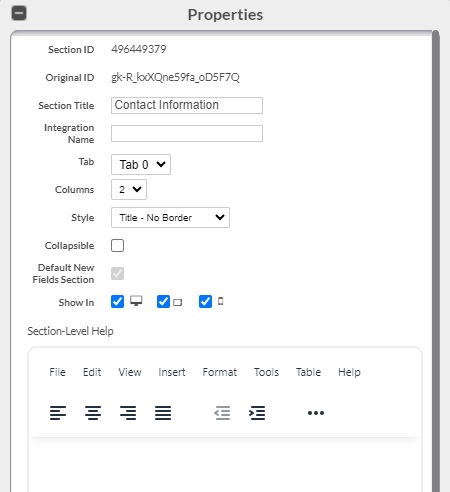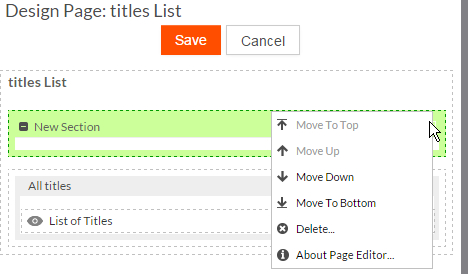Adding and configuring sections
Sections allow you to organize page components into different groups and columns. Add a section to a page by dragging the New Section component from the left sidebar onto the page.
Configure a section by opening the Properties menu next to the section title:

Section properties include:
- Section Title — The title displayed at the top of the section
- Section Integration Name — The integration code of the section. For information on the corresponding API, see rbf_getSectionIdByIntegrationName().
- Tab — For record view pages only, the tab associated with the section. By default, record view pages include tabs to view record information and to view system information, and you can associate each section with one of these tabs and create new tabs.
- Columns — The number of columns in the section. By default, sections on the page are aligned from top to bottom in one column. You can configure a section to contain up to four columns and organize components by dragging them from one column to another.
- Style — Specifies whether the Section Title is displayed on the application page and whether there is a border around the section.
- Collapsible — Specifies whether a user can collapse the section on the application page.
- Default New Fields Section — When checked, any new fields added to the object will appear in this section of the page. A page can only have one default new fields section.
- Show In — Specifies whether this section is displayed on desktops, tablets, and/or smartphones. Displays on all devices by default. Deselect a device type if you do not want the section displayed on it. The icons representing devices appear in the following order: desktop, tablet, smart phone.
- Section-Level Help — Customize the section with a help information, see Section level help for more details.
You can use the section menu at the top right corner of a section to move the section on the page or to delete the section:

Note:
-
Tab and section integration codes must be unique within a page, but a tab and section can share the same integration code.
-
When adding or modifying a tab or section code that already exists on the same page, the code is automatically incremented upon saving the page to avoid conflicts.
-
For instance, if a tenant initially has a tab with the code
Tab_0 and adds a new tab with the same code, the new tab's code will be modified toTab_01upon saving.
-
-
However, during an application upgrade, if the incoming XML contains a tab code that conflicts with an existing one on the same page, the upgrade process will be halted.